When users click from a Google Business Profile to a behavioral health facility’s website, the landing page experience determines conversion success. This wire-frame examines how strategic design choices can optimize both user engagement and local search performance.
Each section serves dual purposes: engaging human visitors while providing structured signals that search algorithms can interpret and recommend.
Please note that not all instances of [City] are required, necessary or recommended, keep it natural avoid keyword stuffing. This is an example.
Full Wire-Frame:
Google Business Profile Landing Page Wire frame
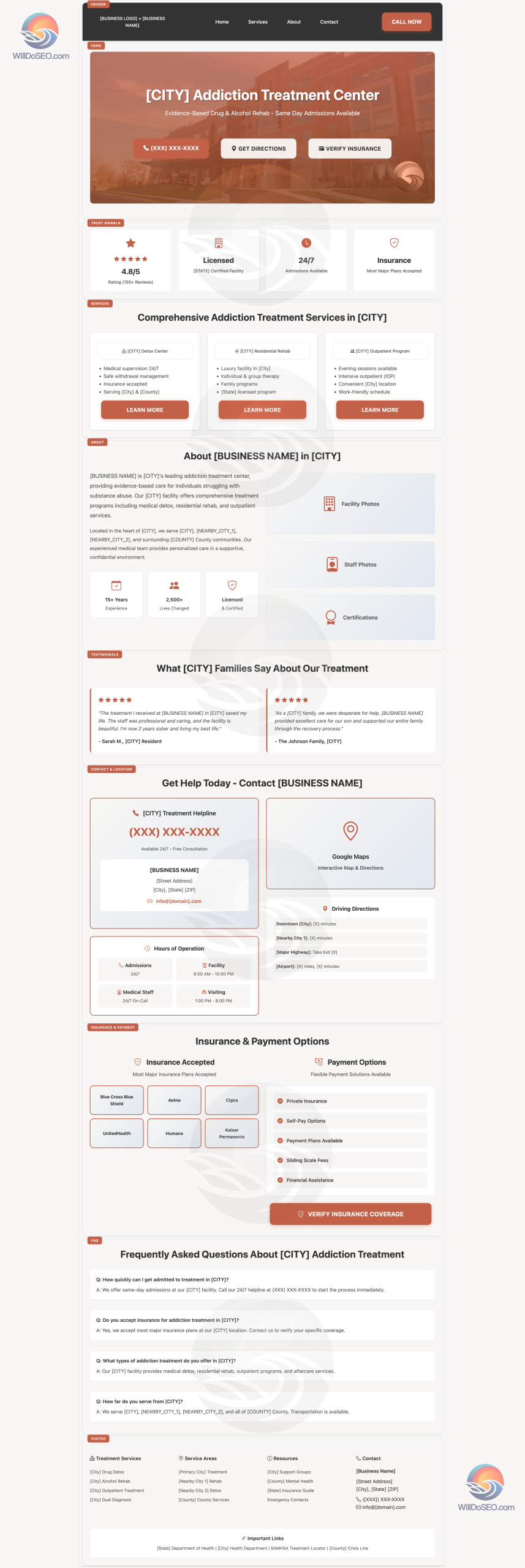
Header Navigation: Foundation of Trust and Accessibility
The header serves as the digital front door, establishing immediate credibility through strategic brand positioning and accessibility-focused navigation.
Strategic Notes:
- Logo placement should include practice name with location modifier (“City Name Addiction Treatment”)
- Navigation structure reflects user intent mapping: Home (overview), Services (solution-focused), About (trust building), Contact (conversion)
- Prominent call-to-action button addresses crisis-driven search behavior common in behavioral health
- Mobile-first consideration essential given 70%+ of addiction treatment searches occur on mobile devices
Local SEO Implications: The header’s treatment of business name and location creates immediate geographic relevance signals. The navigation terminology should mirror language patterns found in local search queries (“Services” vs “Programs” based on local search volume data).
Hero Section: Emotion Meets Optimization
The hero section serves two needs: getting crisis searchers to conversion quickly while building the local search signals that drive traffic.
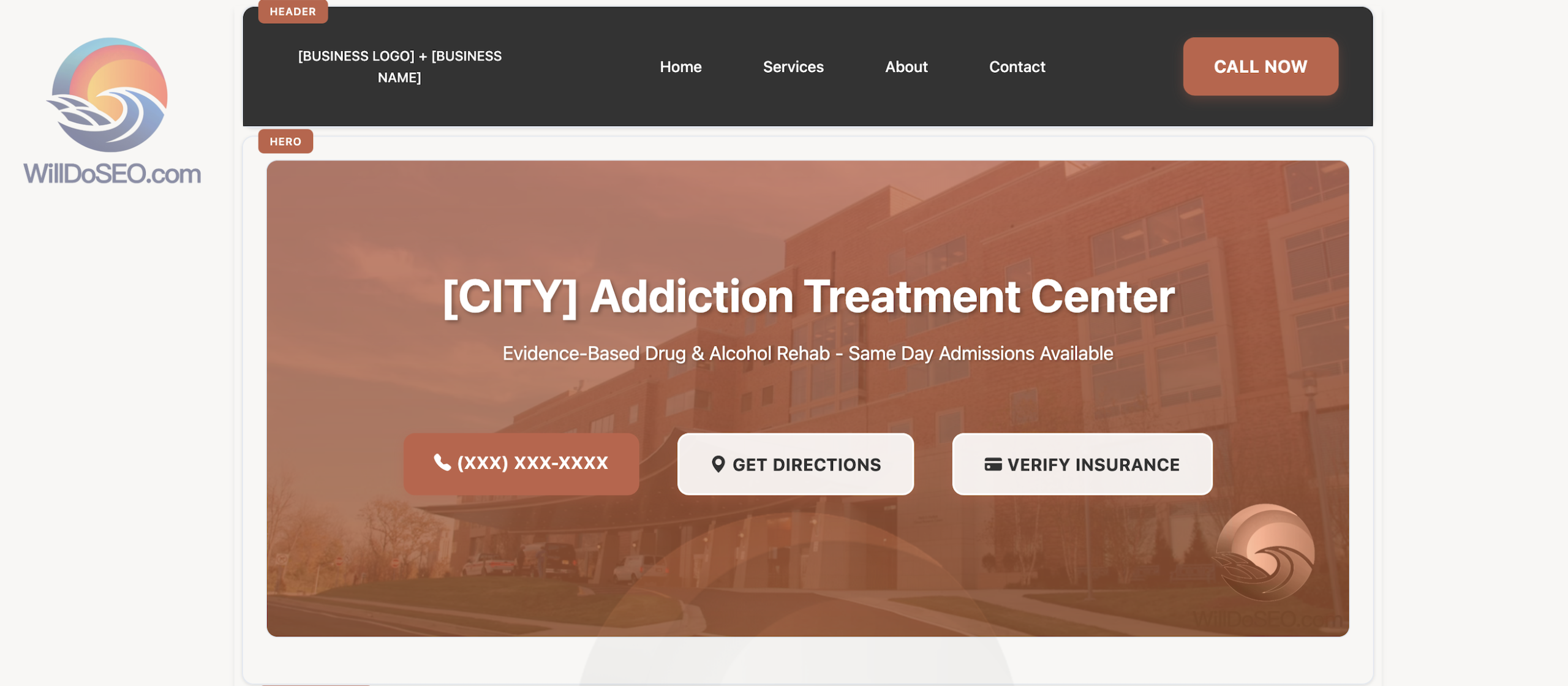
Psychological Design Elements:
- Visual hierarchy prioritizes emotional connection (healing imagery) before logical appeals (certifications)
- Multiple CTA options acknowledge varying user readiness levels (phone call, directions, insurance verification)
- Geographic specificity in headlines creates immediate local relevance
Technical SEO Considerations:
- H1 tag structure should follow “[City] [Service Type] [Facility Type]” pattern for maximum local search relevance
- Schema markup opportunities for LocalBusiness, MedicalOrganization, and Place entities
- Image optimization requires descriptive alt text including location and service modifiers
Conversion Optimization Notes: The three-button CTA group addresses different user intents: immediate help-seeking (phone), practical logistics (directions), and financial concerns (insurance). This multi-path approach increases conversion probability across varying user states.
Trust Signals: Data-Driven Credibility
The metrics section transforms abstract credibility into measurable trust indicators.

Strategic Implementation:
- Review aggregation should display actual Google Business Profile rating with review count
- Licensing information builds regulatory credibility while supporting “near me” search relevance
- 24/7 availability addresses crisis-nature of many behavioral health searches
- Insurance acceptance removes primary conversion barrier upfront
Local SEO Value: These elements support Google’s E-A-T (Expertise, Authoritativeness, Trustworthiness) evaluation criteria while providing structured data opportunities for rich snippets in local search results.
Services Section: Local Intent Optimization
The three-service grid defines services clearly with geographic specificity (‘[City] Residential Rehab’) while creating internal links that distribute local search equity and target location-based treatment queries.
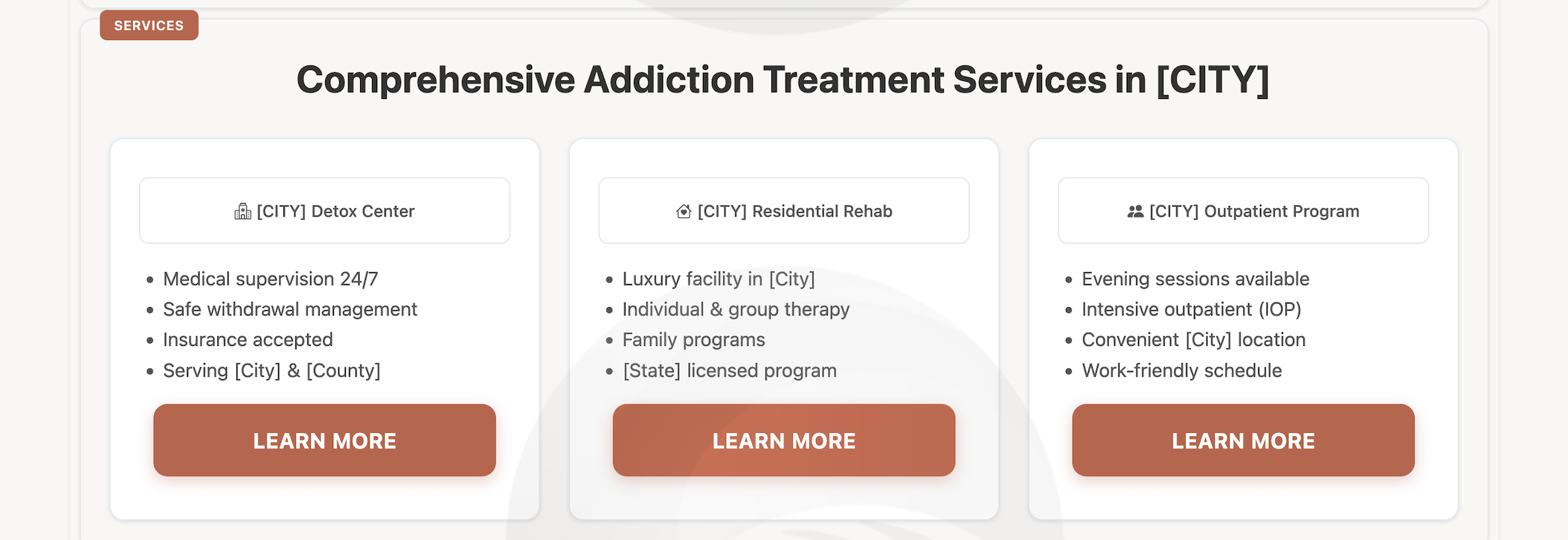
Content Strategy:
- Service titles include location modifiers (“[City] Detox Center”) for local search optimization
- Feature lists use patient-benefit language rather than clinical terminology
- Geographic coverage explicitly states service areas for local search relevance
Technical Implementation:
- Individual service pages should exist for each offering with dedicated local optimization
- Internal linking strategy from this section to detailed service pages supports site architecture
- Schema markup for Service and MedicalProcedure entities enhances search visibility
User Experience Considerations: The uniform card design with clear CTAs maintains visual consistency while allowing users to explore specific interests without cognitive overload.
About Section: Authority and Local Connection
The about section establishes local authority through geographic repetition while building dual credibility: facility photos provide visual transparency of the treatment environment, and clinical metrics (15+ Years Experience, Licensed & Certified) establish medical expertise, both essential for behavioral health conversions.
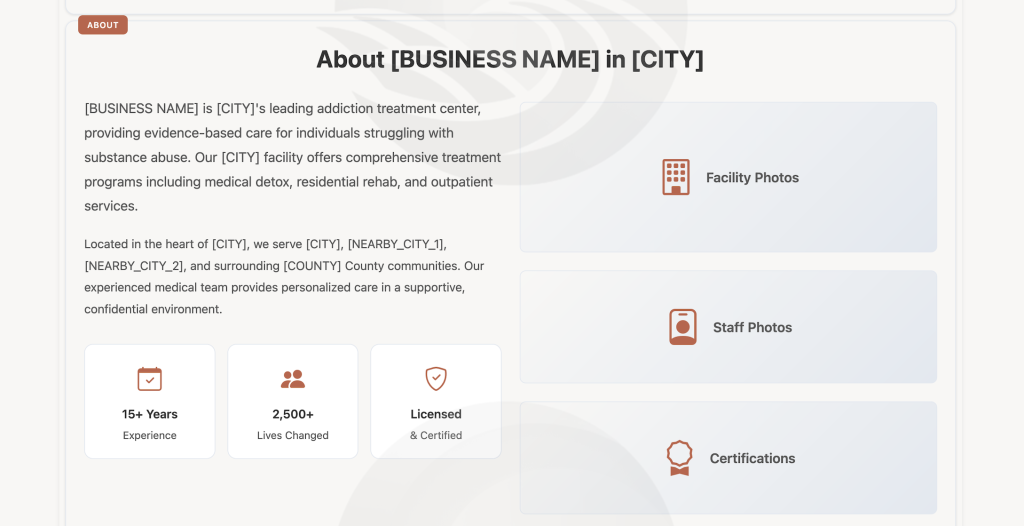
Content Architecture:
- Geographic specificity throughout copy reinforces local relevance signals
- Experience metrics (years, lives changed) provide quantifiable trust indicators
- Visual elements (facility photos, staff photos, certifications) support transparency expectations
SEO Optimization Opportunities:
- Structured data for Organization and Person entities (medical staff)
- Local citation consistency ensuring NAP (Name, Address, Phone) alignment across mentions
- Community connection language strengthens local relevance for “near me” searches
Testimonials: Social Proof with Local Context
The testimonial section leverages local social proof by featuring [CITY] residents and families, reinforcing geographic relevance while building trust with potential patients from the same community.

Compliance Considerations:
- Privacy protection through first name and last initial only
- Geographic attribution (“[City] Resident”) maintains HIPAA compliance while supporting local SEO
- Authentic language patterns that avoid overly promotional tone
Local SEO Value: Geographic references in testimonials support local relevance signals while the review star display reinforces Google Business Profile rating consistency.
Contact & Location: Conversion Optimization Hub
The contact section represents the primary conversion point, requiring careful balance between accessibility and information architecture.
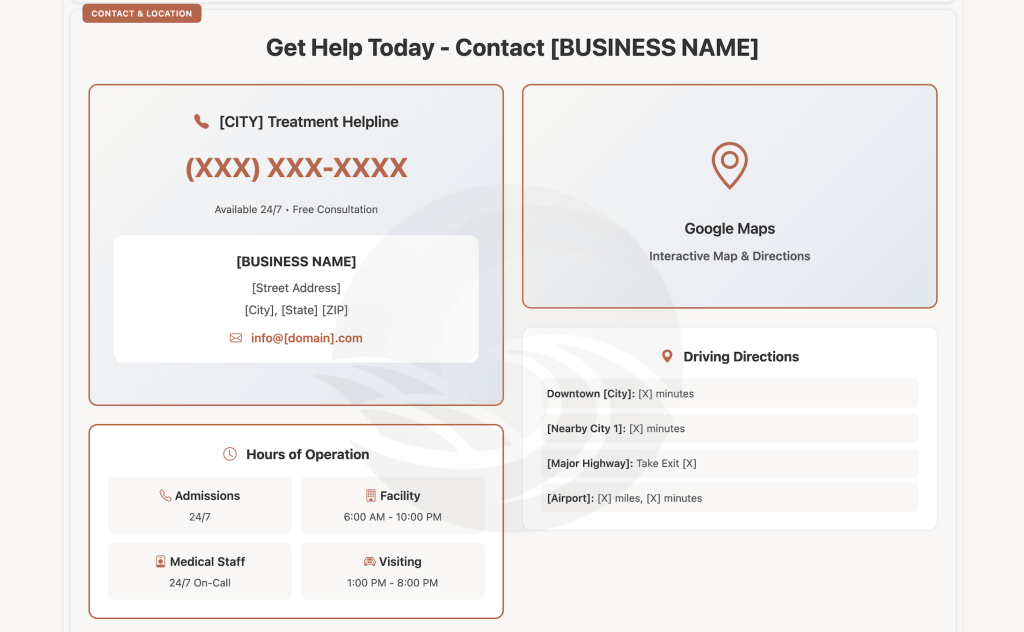
Strategic Elements:
- Multiple contact methods accommodate varying user preferences (phone, email, location)
- 24/7 messaging addresses crisis-driven search behavior
- Geographic context (driving directions, nearby landmarks) supports local discovery
Technical Implementation:
- Schema markup for ContactPoint and Place entities
- Google Maps integration improves local search signals and user experience
- Structured hours data supports Google Business Profile optimization
Insurance & Payment: Barrier Removal Strategy
The insurance section proactively addresses the primary conversion barrier in healthcare: financial concerns.
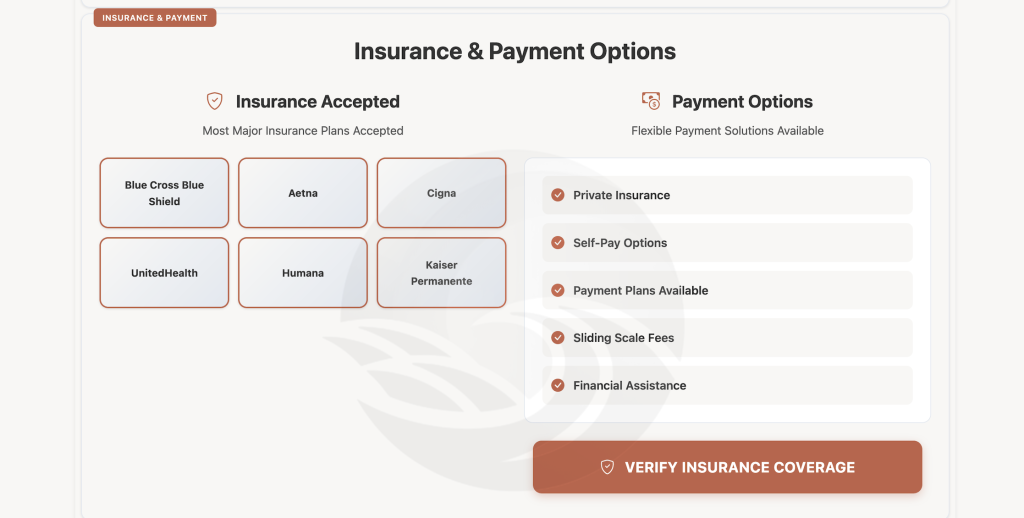
Psychological Design:
- Visual insurance logos create immediate recognition and reduce anxiety
- Comprehensive payment options address varying financial situations
- Prominent verification CTA moves users toward conversion action
SEO Considerations: This section supports long-tail local searches including insurance-specific queries (“Blue Cross addiction treatment [city]”).
FAQ Section: Search Intent Mapping
The FAQ structure demonstrates sophisticated understanding of user search patterns and local SEO optimization.
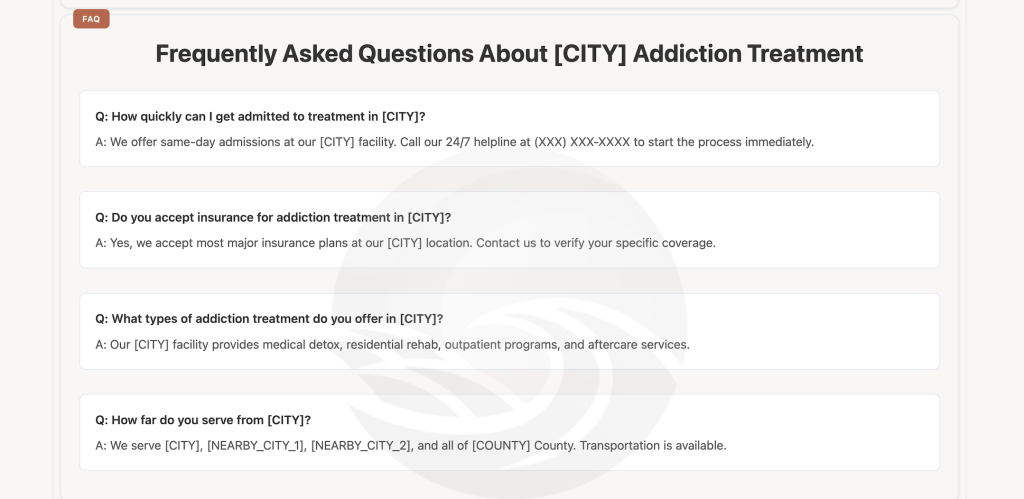
Note: Not all FAQ need location modifiers
Content Strategy:
- Geographic integration in questions mirrors local search patterns
- Practical focus addresses real user concerns rather than promotional content
- Immediate answer format supports featured snippet optimization
Technical Value: FAQ schema markup opportunities enhance search visibility while the question format aligns with voice search optimization.
Key Implementation Principles
Dual-Audience Optimization
This wire-frame exemplifies the dual-audience approach essential in modern local SEO: creating content that resonates emotionally with humans while providing structured signals that AI systems can interpret and recommend.
Geographic Consistency
Throughout every section, location references maintain consistency, supporting local search algorithms while creating community connection for users.
Crisis-Aware Design
The design acknowledges that behavioral health searches often occur during crisis moments, prioritizing immediate access to help over extensive information gathering.
Measuring Success
Success metrics for this type of landing page should encompass both traditional conversion indicators and local search performance:
- Local search visibility across target geographic areas
- Google Business Profile engagement metrics (clicks, calls, direction requests)
- Conversion rate optimization across different traffic sources
- Multi-touch attribution recognizing the complex behavioral health decision journey
Implementation of these elements, combined with ongoing optimization based on performance data, creates a foundation for sustainable local search success in the competitive behavioral health market.
Does your current landing page convert Google Business Profile traffic? Consider implementing a similar strategic approach to maximize both local visibility and patient conversions. Schedule a consult.
WillDoSEO.com

